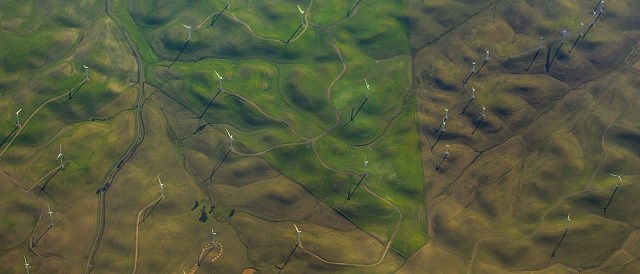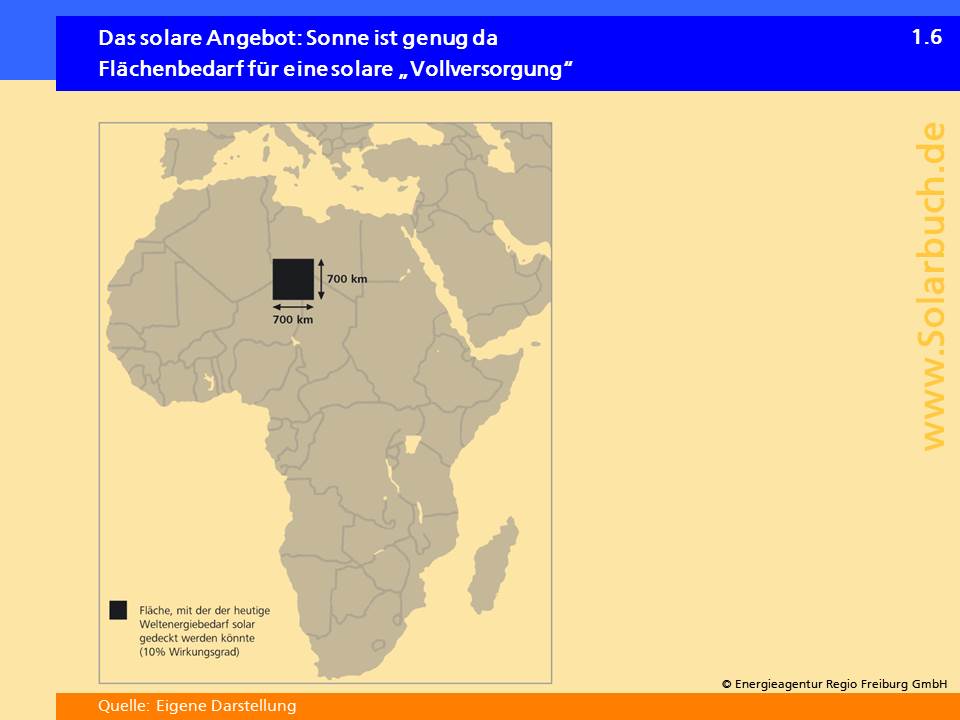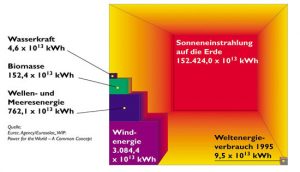A recent scientific paper wondered whether the potential of wind power worldwide has not been overestimated. Craig Morris could not help noticing that the calculation was based on something he has never seen it used in the German debate: watts per square meter.

Watts per m² – Germans are not worried about theoretical limitations. They just build renewables and realize in the process that they can make more energy than they need. (Photo by Alexander Franke)
Published in March, the paper states that the energy density of wind farms larger than 100 square kilometers is probably around a single watt per square meter partly because of the wake effect (a wind turbine takes some of the energy out of the wind for turbines directly behind it).
In essence, the discussion is nothing new. The Danes and Germans have been working on the wake effect since the 1990s in designing large wind farms, especially in terms of the spacing between individual towers and their arrangement.
How big is 100 square kilometers? Germany’s first commercial wind farm, Baltic 1, has a rated capacity of 48.3 megawatts across seven square kilometers. Most German wind farms are much, much smaller, however, and do not have nearly the estimated rated capacity of these offshore wind turbines: 44%. In contrast, the rated capacity of Germany’s onshore fleet is reliably below 20 percent, which cuts energy density in half.
Yet, Germans do not seem concerned about any theoretical limits. On the contrary, German Environmental Minister Peter Altmaier has frequently complained about the numerous German states that want to become 100 percent or more renewable, which has prompted him to ask which of the other German states plan to buy all of that green power.
One recent example comes from a presentation held recently by SMA’s CEO Pierre-Pascal Urbon, who pointed out that Germany is currently only using 20 percent of its suitable commercial and industrial roof space for photovoltaics – and only five percent of its suitable residential roof space. Nonetheless, Germany has 1.4 million solar arrays already installed (including ground-mounted) – in a population of 80 million with approximately 22 million households.

A popular chart from the 1990s in Germany showing that the size of a solar array in the Sahara that would theoretically produce the equivalent amount of energy (not just electricity!) that the world consumes. Source: Das Solarbuch.
And then there is das Solarbuch, one of the best known books on renewables in German. It contains a slew of graphics, such as the one showing a box in the Sahara indicating the area that would need to be covered with solar panels to meet the world’s energy needs – not just electricity.
Another graphic made the rounds way back in the 1990s. It shows a little box on the bottom right representing global energy consumption (not just electricity) in 1995. Then, there are boxes on the left for (from top to bottom) the potential of hydropower, biomass, ocean energy, and wind power – all of which is set inside a large box representing the amount of sunlight that hits the earth each day.

This widely circulated chart from the 1990s shows that Germans have always emphasized that the potential of renewable energy is much greater than our current energy consumption. Source: Ralf Bischof, Bundesverband Windenergie (BWE)
Each of these comparisons is silly in its own way. For instance, Urbon was not able to tell me what is meant by “suitable” (just south-facing roofs, or also southern façades and roofs facing the east and west?). The map of Africa seems to suggest that we should focus on large solar farms in the desert, not small solar roofs where we live (Germany is doing the latter). And the boxes represent the energy available, not anything that could be feasibly harvested (70 percent of the Earth is covered with water anyway, and you can’t cover your cities and farmland with infrastructure, solar, wind turbines, and biomass crops simultaneously).
But that’s not my point. I’m just trying to show how different the discussion is. While the Anglo world continues to wonder whether a switch to renewables is even possible theoretically, Germans are just switching – and we will find out what needs to be done in reality as we go.
Craig Morris (@PPchef) is the lead author of German Energy Transition. He directs Petite Planète and writes every workday for Renewables International.
[…] is repeated even today, most recently in a scientific paper that drew a lot of attention. But as I recently wrote in the Energy Transition blog, almost no one in Germany speaks of energy density; the Germans […]
Craig,
You’re wrong and your bias is rather obvious. You are a true believer in renewables and no matter how poor the economics you will consistently deny the facts.
1. German solar farms have hideously poor load factors. Around 12%. Producing virtually during the peak season for electricity – winter.
2. Solar panels have poor physical efficiency ranging from 10% to 20%.
3. David MacKay work settles this issue. Both solar and wind farms produce low amounts of electricity on a square meter basis, and yes, land is a scarce resource.
Roderick, let us assume that Craig is simply just wrong. Let us assume too, that the economics are really poor.
I would still go for the renewables, that is me, David Svarrer, as I do not understand the idea that we can combust any kind of fossil fuel or any kind of radioactive fuel.
The fossil fuels has taken some millions of years to become fossil fuel. Yet we think that if we combust these in some few hundreds of years, then that is sustainable?
The radioactive fuels are some hundreds of factors more efficient per kilogram of fuel, however, is it sustainable to combust a kilogram of uranium, only to have to store the residual plutonium for hundreds of thousands of years, accumulating the number of manhours and machine hours necessary to maintain the storages for each kilo we continue to consume?
The consequence of this is, that at SOME point the renewables will, no matter what, be cheaper than any combustible kind of fuel, only with the difference, that at that time, we have reached a very unfortunate equilibrium where it is now more costly to use either oil, coal or uranium than what we get out of it.
Furthermore – for the uranium part – the rise in price – is caused by the maintenance cost – so – we have at that point gotten ourselves a nice problem – namely to use renewables to maintain the enormous stockpiles of plutonium, in a way such that they do not cause harm to mankind.
Add to this, that these stocks have to be inspected, re-loaded, moved, with few decades in between, due to that the tanks these are stored in, smoulder due to the radiation. These effects are documented in hundreds of reports.
So, Let me be wrong with Craig, and let me do renewable energies even if these are 10 times or more expensive. Because: YOU cannot take plutonium, which is a whole new material, and combust it at a high temperature to break it down. But any and all materials being used to manufacture solar cells, wind mills, water power stations, all of these materials – are recyclable and once the wind mill is dismantled, it can be recycled.
And beware and behold. I have for instance installed a water heater in my house, built by myself as an instant heater, with available normal plumbing materials, a few wrenches aso. – and now my family takes hot shower every day – from the sun. Total cost: around 120 USD. Yes – One Hundred and Twenty.
Then add my labout – maybe 40 hours.
We have now showered for 3 months like this.
We have solar cells and a small solar battery of 70 Ah (buying another one soon), for light. We have cut our electrical bill from the grid by 80%.
The solar cells and so on has cost some USD 300 or so in total in material, plus my labour – around 30 hours in total.
What I have done is not very advanced, but I have made it extremely usable, very simplistic, and the outcome is very efficient.
I have entered the comment above, here:
https://docs.google.com/document/d/1e1cGAjn-jgAUIOJx685bbGoBBYoZA9By2UobmlU5A1U/edit#